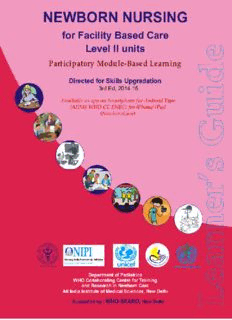
3-Ed-2014-FBNC-Nursi.. PDF
Preview 3-Ed-2014-FBNC-Nursi..
3rdEdition,January2014-15 1stEdition,July2004 2ndEdition,2009 Compiled by Faculty, Residents and Nursing Staff of the WHO Collaborating Centre for Training and Research in Newborn Care, All India Institute of Medical Sciences, New Delhi, in collaboration with Collegeof Nursing,AllIndiaInstituteof MedicalSciences,NewDelhi. ThispublicationissupportedwithfundsprovidedbyWHO-SEAROasapartof APWwithDepartmentof PediatricsWHO-CC,AIIMS,NewDelhi. Itscontentsaresolelytheresponsibilityof theauthorsanddo notnecessarilyreflecttheviewsof WorldHealthOrganization. The protocols and recommendations in the module are based on an extensive review of available literature and the standard practices in leading neonatal centres in the country. The publications of the World Health Organization, Saving Newborn Lives, American Academy of Pediatrics, JHPIEGO, KangarooFoundationandNationalNeonatologyForum,amongothers,served as important sources of information. The evidence-based principles of newborncarewerecarefullyadaptedforapplicationintheoperationalmilieuof small facilities. Medical and nursing knowledge keeps changing rapidly. Therefore,theusersof thisGuideareadvisedtorefertoliteratureandamend thesepracticeswithpassageof timetosuitthesituationprevalentintheirunits. Thepracticesandpoliciesmayvaryfromonefacilitytoanother,hencetherecan benouniversalrecommendations.Thepracticesmentionedinthisguidearejust guidelinesandarenottobetakentobefirmandfinalortheonlywaytoperform such procedures in newborn. The authors or sponsors will in no way be responsible for any harm or damage to patients, care givers or equipment resultingfrommisinterpretationormisuseof thesepracticeguidelines. Publishedby Divisionof Neonatology, Departmentof Pediatrics,AIIMS,NewDelhi ThismaterialispublishedbyNeonatalDivision,Departmentof Pediatrics,AllIndiaInstituteof Medical Sciencesforgeneraldistribution.Allrightsarereserved. Subjecttodueacknowledgment,thisdocument may,however,bereviewed,abstracted,reproducedortranslated,inpartorinwhole,providedthatsuchis notdoneforcommercialpurposes. Design&Printed by M/sPapyriPrints NewDelhi.Tel:9717889018 C O N T E N T S Module I : Care of the normal baby at birth Module 2 : Thermal Protection Module 3 : Kangaroo Mother Care Module4: Feedingof NormalandLowBrithWeightBabies Module5: Resuscitationof theNewbornBaby Module6: CommonProcedures Module7: Preventionof InfectionHouse-KeepingandWasteDisposal Module8:Careof At-riskandSickNeonates Module 9 : Common Equipments & Troubleshooting Annexures References KAP Questionnaire Key Operationalization Criteria of Essential Newborn Care FOREWORD Ensuringhealthysurvivalof allneonateshasclearlyemergedasakeyareaforimprovingchildhealth.The globalcommunityhascommitteditself toattainanunder-fivechildmortalityrateof lessthan20per1000 live births in all counties by 2035. This would only be achieved if the neonatal mortality rate declines to under10per1000births.ForIndia,thiswouldbeatwo-thirdsreductionfromtheprevailinglevelof 29. Since 99% of neonatal death occur in middle and low income countries, the strategies and tools that are appropriateforthesesettingsareurgentlyrequiredtobedeveloped,disseminatedandtranslatedintoaction. Investments in newborn nursing is all the more important as staff nurses are identified as one of the important service providers to deliver the recently launched Every Newborn Action Plan (ENAP). The Newborn Nursing for Facility Based Care intends empowering nurses to provide skilled care to sick and prematureneonatesforuseinIndiaandinotherdevelopingcountries. Careof mothers,neonatesandchildreninsmallhospitalsislargelyshoulderedbyournursingcolleagues.It isthenurseswhoprimarilyprovidethelife-savinginterventionstothebabies,enablethemothersfortheir babiescare,andcounselthefamilies.Nurseshaveanimportantroleinallclinicaldisciplines,butforneonatal caretheirroleasskilledprofessionalswithhumantouchiscentral.Forqualitycareitisessentialtohavewell trainedhealthacreprofessionals.Thepresentpackageaimstostrengthentheircorecompetence.Thefocus is on skills and the approach is participatory. We proudly believe that this resource material is of global standardsandisrelevantnotonlyinIndia,butalsomanyothercountriesacrosstheworld. Iwouldliketocongratulatethecontributors,reviewersandtheeditorialteamforaproductof outstanding educational and technical quality. It is indeed remarkable that a majority of contributors are experienced nurses themselves. Professor A K Deorari has set new standards in training methods and technology throughthiseducationalendeavour.Iwarmlycomplimenthimforhisstellarleadership. I am sure this training resource material will contribute toward saving many newborn infants in years to come. Prof.VinodPaul Incharge,WHO-CCforTrainingand ResearchinNewbornCare Head,Departmentof Pediatrics AllIndiaInstituteof MedicalSciences 14thNovember2014 PREFACE Nursesplayapivotalandvariedroleinmanydevelopingcountrieshealthcarefacilities,includingproviding prenatal education, labor and delivery, and ongoing newborn care. Most notably, it is nurses who are providing skilled attendance during birth, performing newborn resuscitation, initial newborn care, stabilizationof at-riskandsicknewborns,anddeterminetheneedfortransfertoregionalhospitalswhen necessary.Inaddition,nursesprovidecounselingtomothersabouttheimportanceof institutingkangaroo mothercareandbreastfeedingaswellasthespecialneedsof lowbirthweightbabies.Duetoashortageof physicians, especially in rural areas in developing countries, the nurses role is especially critical at district, sub-district areas, and villages. Often they perform critical care procedures and look after neonatal equipment. There is no well-structured or standardized in-service training program in newborn care for nurses employedatabovehealthfacilities.Thenewborncarecurriculuminthepre-servicetrainingcourseof the nursesisoftenscantyandtheoretical.ItisinthisbackgroundthatAIIMStookaleadindevelopingahigh quality training module directed to clinical care practices on Newborn Nursing for facility based care buildinguponearlierpackageofessentialnewbornnursingof 2009.Themoduleusesparticipatorylearning methodologyusingself reading,self evaluation,demonstration,oraldrill,roleplay,casediscussion,group work, video and clinical skill demonstration. The entire package is also available on smart phone as a memorytool. AIIMS team are indebted to the contributors for their outstanding efforts in providing technical inputs. RotaryInternationalFocusGroupStudyExchangeprogrammebetweenRotaryDistrict3010(Delhi,India) and Rotary District 5360 (Calgary, Canada); support for workshops from UNICEF in September 2000; LaerdalFoundation,NorwayinJan2003;DFID,BritishCouncilMarch2004;WHO-SEARO2007-08and fundssavedfromcontinuingmedicaleducationof DoctorsatAIIMShavesowntheseedforthisinitiative. WewouldliketoexpressourappreciationtoteamatCentreof MedicalEducation&Technology,AIIMS for developing video films. Special thanks to NIPI (Norway India Partnership Initiative) and UNICEF UNICEFIndiaofficefortheongoingsupportfordisseminationandcapacitybuildingof newbornnursing inIndia. Prof.AshokDeorari WHO-CCforTrainingand ResearchinNewbornCare Head,Divisionof Neonatology AllIndiaInstituteof MedicalSciences NewDelhi-110029 NewbornWeek2014 Module1-Careofthebabyatbirth CARE OF THE NORMAL BABY AT BIRTH The module is designed to complement in-service education and orientation of health personnel involvedincareofnewborns. LEARNING OBJECTIVES At the end of this session, participants will be able to: (cid:2) Describe basic needs at birth and every day care of the newborn baby (cid:2) Describe evidence-based routine care of a newborn baby at birth (cid:2) Enumerate the components of 'Clean chain' and 'Warm chain' (cid:2) Educate mother how to look after her baby and what to do if her baby is sick MODULE CONTENTS M The module includes following elements: o (cid:3) Textmaterial:Easytoreadformatforquickreproductionandessentialreferencematerial d u fortheparticipants.Keymessagesarehighlightedintheboxes. l e (cid:3) Role-play: Observing the steps of normal newborn care at birth. Participant will also be I : providedwithanopportunitytodoroleplay. C (cid:3) Demonstration:Demonstrationofimmediatecareofcordandeyeatthetimeofbirth. a r (cid:3) Self-evaluation: At the end of text, self evaluation based on what has been learnt is e o included.Feelfreetoconsultyourtextmaterial,ifyouneedassistanceinrecapitulating. f t h I. CARE OF BABY AT BIRTH e n o r m 1. INTRODUCTION a l Thefirsthourafterbirthhasamajorinfluenceonthesurvival,futurehealth,andwellbeingofa b a newlyborninfant.Thehealthworkershaveanimportantroleatthistime.Thecaretheyprovide b during this period is critical in helping to prevent complications and ensuring survival. All y a mothers need help, support, and advice in the initial few days after delivery to ensure proper t b careoftheirnewlybornbaby. i r t 2. THEBASICNEEDSOFANORMALBABYATBIRTH h ThefourbasicneedsofALLbabiesatthetimeofbirth(andforthefirstfewweeksoflife)are: i. Warmth ii. Normalbreathing iii. Mother'smilk iv. Preventionofinfection Thesebasicneedsindicatethatababy'ssurvivalistotallydependentuponhermotherandother caregivers. Therefore it is important to provide proper care to all the neonates immediately after birth. All newborns require essential newborn care to minimize the risk of illness and maximize their growth and development. This care will also prevent many newborn emergencies. For example, the umbilical cord may be the most common source of neonatal sepsis and also of tetanus infection, and good cord care can dramatically reduce the risks of these serious conditions. Exclusive breastfeeding has a significant protective effect against infections. Early breastfeeding and keeping the baby close to the mother reduce the risk of hypothermiaandhypoglycemia. NeonatalDivision,AIIMS,NewDelhi -1-
Description: